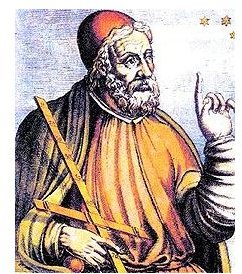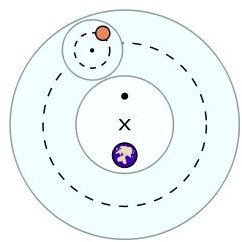Ptolemaic Theory -- An Ancient System for Understanding Our Solar System and the Universe
Birth of an Idea

Imagine you are a primitive human attempting to make sense of the Universe. You try your best to piece together a reason for the way things are, based on what you can see and otherwise sense. What are your clues?
Earth seems huge and immovable. The Sun and Moon seem much smaller and they move across the sky. The stars and planets seem far smaller—mere points of light—and also move across the sky. You have no way of knowing the distance to those objects, and thus their actual sizes. You can only go by your senses. But how would you explain the movements of those mysterious objects in the sky?
The Moon, Sun and planets each have their own, individual schedule, while the stars seem to move together as one fixed pattern.
The Ptolemaic theory of the Universe was born of such simple observations.
Ptolemy, the Man

Claudius Ptolemy lived in Greek-influenced Egypt under the rule of Rome, from about 90 to 168 AD. This spanned the reigns of Roman Emperors Domitian, Nerva, Trajan, Hadrian and included the early reign of Marcus Aurelius.
Not much is known about his life, but he became famous for his works in geology, astronomy, mathematics and astrology. He is not to be confused with the Ptolemy’s (Ptolemaic Dynasty) who ruled Egypt after its conquest by Alexander the Great (332 BC).
Ptolemy is perhaps best known for his treatise on the heavens, known to us as Almagest.
The Almagest
The name “Almagest” is an English spelling of the Arabic, al-majisti, which was, a rough translation of the original Greek title, He Megale Syntaxis (The Great Treatise).
Ptolemy’s most famous work contained thirteen sections, called “books.” These contained an impressive quantity of data including a catalog of more than a thousand stars, their positions and magnitudes (a system still used in modified form by today’s astronomers), the motions of the planets, and even Hipparchus’ legendary discovery of precession of the equinoxes.
Based on the philosophy and writings of earlier Greeks, the Ptolemy’s ideas held that Earth was at the center of everything and that all other celestial objects revolved around it. All celestial motions were thought to be those of perfect circles. The ancient Greeks were heavily influenced by shapes in their most perfect or simplest form.
For over a thousand years, the Ptolemaic ideas were the basis of all astronomical science. The highly influential Catholic Church, during the Middle Ages and early Renaissance, supported Ptolemy’s work, because it seemed only natural that God would place the home of his children in the center of everything. The Ptolemaic universe supported that belief.
Ptolemy’s Hypothesis

With Earth at the center, Ptolemy felt that each object (except for the individual stars) was held by its own sphere. From Earth, the spheres were those of the Moon, Mercury, Venus, the Sun, Mars, Jupiter, Saturn and finally all of the stars on one sphere.
Each of the planets also possessed at least one additional sphere which caused its peculiar motions, like the retrograde motion of Mars when it seems to reverse course for several days. The original, larger sphere is called the “deferent.” The center of the deferent resides halfway between the Earth and a theoretical point called the “equant.” Onto that deferent sphere, a secondary, smaller sphere, called the “epicycle” moved the planet in a small circle while the epicycle moved in a larger circle around the deferent.
Sound complex? Ptolemy’s system was a big improvement over the previous versions. Though it was not perfect, it helped predict the positions of planets with greater accuracy.
Resistance to Change
During the Renaissance, scientists like Nicolas Copernicus (1473–1543), Johannes Kepler (1571–1630) and Galileo Galilei (1564–1642) challenged Ptolemy’s ideas. They offered what they felt was a better explanation. And Copernicus started this change fever, offering that a heliocentric (Sun-centered) Universe made a simpler, more elegant explanation.
Any idea carries with it a certain inertia. A long-established idea remains almost unstoppable. Try convincing someone that the Moon is made of Swiss cheese and that the Sun is made of cream cheese. Changing anyone’s mind to this new way of thinking would prove nearly impossible, unless they were very hungry for cheese.
But seriously, Ptolemaic theory had been working for over a thousand years. That’s a lot of inertia. Add to that the invested egos of church elite who felt that moving Earth from the center of everything would go against the word of God. Ouch! But in reality, any change from Ptolemy’s ideas would only go against their interpretation of the Holy Book. Big difference! Galileo, who was born eleven years after Copernicus died, ran afoul of that church-invested inertia and spent the last decade of his life under house arrest for his seeming heresy in support of Copernicus.
Changing of the Guard
Science changes as new discoveries are made, but like giving birth, new ideas are frequently resisted painfully—even today.
The idea that the stars are fixed could not withstand the observations of British astronomer Edmund Halley. In 1718, he made it known that three of the brightest stars in the sky—Aldeberan, Arcturus and Sirius—were not where they were supposed to be according to the Almagest and according to the earlier tables provided by Hipparchus, nearly two thousand years before Halley. And so, Halley had discovered the “proper motion” of the stars—an astronomical concept still widely used by modern science.
British astronomer William Herschel (1738–1822) made observations of double stars, which challenged the notion that the Sun is at the center of the Universe. He found that those double stars had their own orbits around a common center of gravity, far, far from our own star. So, even the heliocentric theory—the one which had replaced Ptolemy’s theory—fell to a newer, better interpretation of things.
Credits
All images are in the Public Domain:
Earth from orbit, provided by NASA.
Image of Claudius Ptolemy from an early Baroque artist’s interpretation, provided by Wikipedia.
Ptolemaic diagram by Fastfission, provided by Wikipedia.
References
- “Ptolemy,” http://en.wikipedia.org/wiki/Ptolemy
- “Almagest,” http://en.wikipedia.org/wiki/Almagest
- “Heliocentrism,” http://en.wikipedia.org/wiki/Heliocentrism
- “William Herschel,” http://en.wikipedia.org/wiki/William_Herschel
- “List of Roman Emperors,” http://en.wikipedia.org/wiki/List_of_Roman_Emperors
- “Galileo Galilei,” http://en.wikipedia.org/wiki/Galileo_Galilei
- “Nicolaus Copernicus,” http://en.wikipedia.org/wiki/Nicolaus_Copernicus
- “Geocentric Model,” http://en.wikipedia.org/wiki/Geocentric_model
- “Proper Motion,” http://en.wikipedia.org/wiki/Proper_motion